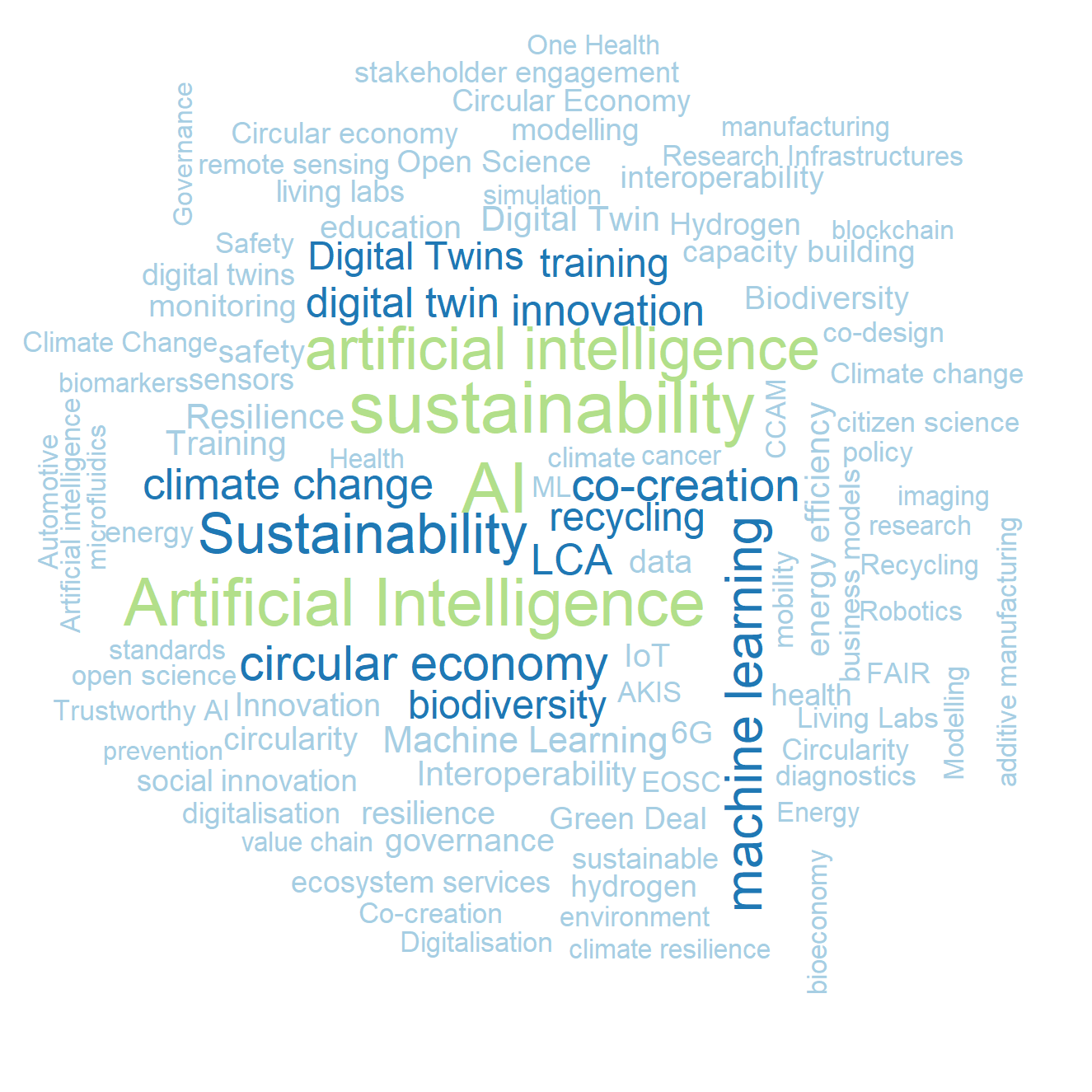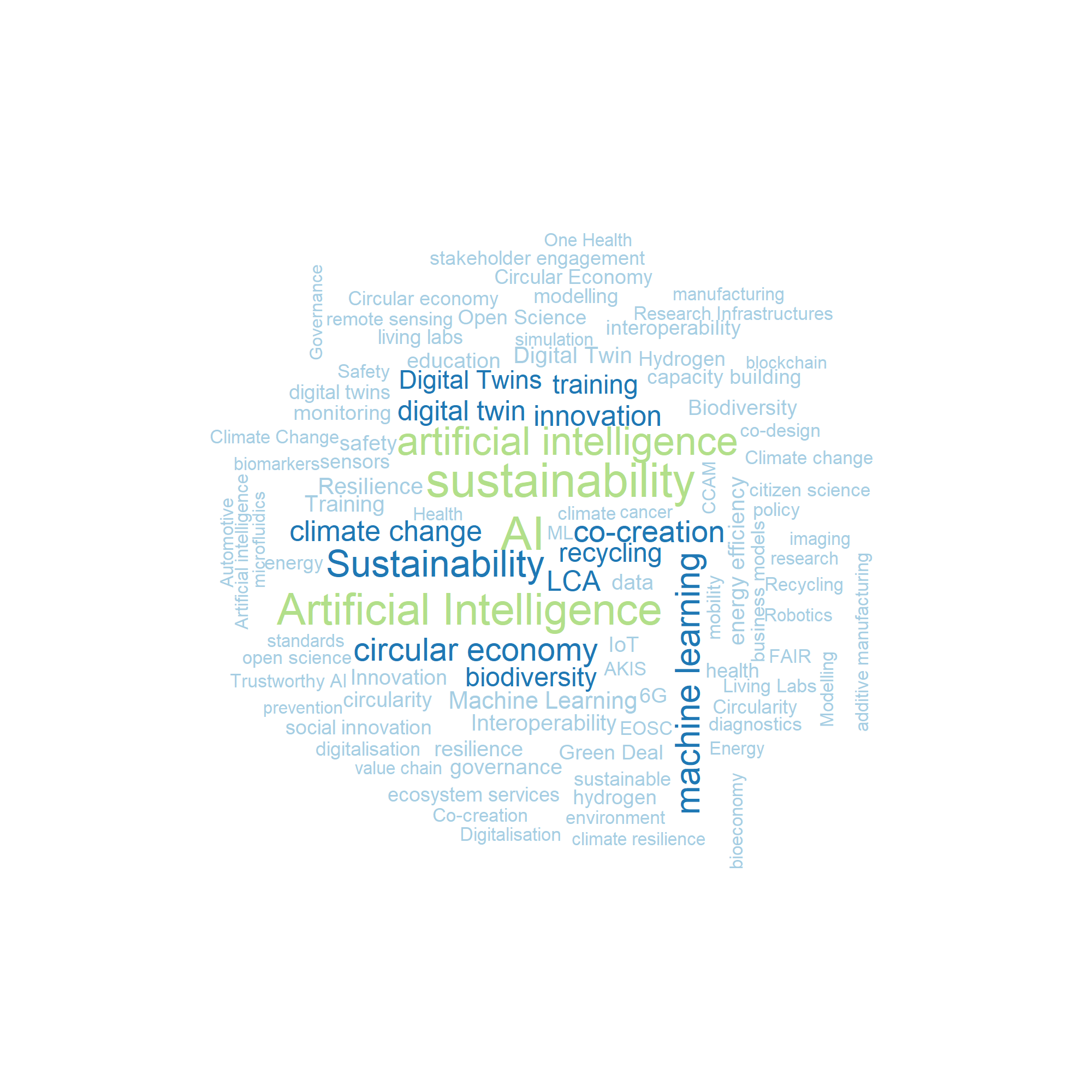Research funding in Europe is currently more in the spotlight than ever before. With the Horizon Europe program, the European Union is investing billions of euros in innovation, sustainability, healthcare, and technology. It is autumn 2025, and the 2021-2027 funding period is slowly nearing its end. It is time to analyze the global distribution of funds, cooperation among institutes, and research topics in order to facilitate well-informed decisions for scientists and the EU Commission as they plan for the next funding period.
- Which countries participate in Horizon Europe funded projects?
- Which research institutions are most frequently involved in Horizon Europe funded projects?
- What are the funded research projects mostly about?
- Which institutions receive the highest funding?
- Which countries receive the highest funding?
- Which institutions and countries are most frequently involved in collaborations?
- Conclusion
The analysis of the Horizon Europe datasets provided valuable insights. The datasets include information on countries, institutes, their funded projects, and maximum awarded amounts. The core findings, enhanced with interactive visualizations and rankings, are summarized below.
Which countries participate in Horizon Europe funded projects?
There are only veryfew countries that do not share any project involvement with European Horizon-funded projects in the world. One of them is Russia. The other countries are color-coded in the map below. You can zoom in and out, or drag and drop to position the map as you wish. The color legend is based on the sum of funded projects per country, normalized by the sum of funded institutes per country.
The highest project involvement per institute is found in countries in Europe, for example, Greece and Denmark. There are, however, visible differences in project involvement between Eastern and Western Europe. Horizon Europe funded projects notably include significant participation from countries across North America, Australia, and Africa, highlighting the programme’s extensive global reach and international collaboration.
Which research institutions are most frequently involved in Horizon Europe funded projects?
The absolute number of project participations per institution is shown in the bar chart below. The country is represented by color.
Funding is concentrated among a few major players that hold leading positions across Europe. The French National Centre for Scientific Research (CNRS) leads by a wide margin, followed by the Spanish National Research Council (CSIC) and the Fraunhofer Society (Germany) in second and third place. Interestingly, Denmark, a rather small country, ranks highly with three institutes among the top 20 (red).
What are the funded research projects mostly about?
To answer this question, keywords submitted with the proposals were assessed. Here, you can see the top 100 keywords as a word cloud, in which the size of each word corresponds to its frequency of occurrence.

It is obvious that AI research projects are heavily funded. It was a much-hyped topic last year during the proposal evaluations. It is also encouraging that sustainability and circular economy are highly ranked as well. However, it is surprising to find so few keywords related to life sciences.
Which institutions receive the highest funding?
The color coding in the plot below reflects the countries of the institutes. The CNRS (French National Centre for Scientific Research) leads by a wide margin, securing the highest funding of approximately 2.55 billion euros. Following CNRS, the major Spanish and Italian research institutions occupy the next top ranks.
The Catholic University of Leuven (KU Leuven) stands out as a top recipient of EU research funding, a position that reflects its exceptional ability to secure substantial grants under Horizon Europe. With more than €170 million awarded across 284 projects, which KU Leuwen reported already in 2023 (source),the university owes its success to a well-developed institutional support system, including dedicated grant writing assistance and strong policies fostering innovation. Closely following KU Leuven is Denmark’s Technical University (DTU), which similarly benefits from robust participation in Horizon Europe and other collaborative research initiatives. Both institutions demonstrate how strategic support structures and focused research expertise translate into high competitive funding, placing them among Europe’s leading research organizations.
From Germany, Fraunhofer Society and Max Planck Society also rank high, reflecting their prominent role in European research. Following these are smaller universities such as Aarhus (Denmark), Ghent (Belgium), and Lund (Sweden), which are notable for their strong research output relative to their size — quite impressive given their scale.
Which countries receive the highest funding?
A review of the funding allocation by country clearly indicates that Western-European nations, specifically Spain, France, Italy, and Germany, receive the highest levels of financial support. This is largely attributable to the high concentration of research institutes in these regions. Spain, for example, receives up to 50 billion € until the end of the funding periods.
Which institutions and countries are most frequently involved in collaborations?
Collaboration is a key driver of research across Europe and the world, and it ensures that funding is allocated effectively. To better understand the research landscape within Horizon Europe-funded projects, a network-based approach was used. This method allows to highlight crucial partnerships and identify the most collaborative institutions.
You can explore the networks yourself. When you hover your mouse over a dot—a so-called node—the names of the institutions will appear. Every node corresponds to one institution. The color of the nodes corresponds to the countries. The node size symbolizes the institution’s participation in Horizon Europe-funded projects.
The connections between the nodes, so-called edges, resemble collaborations, and the thickness and color intensity of the gray edges symbolize how often the institutions collaborate.
For the following network, I filtered the top 50 institutions that occur most frequently in the dataset.
This network highlights the most frequently appearing institutes overall. This means that the institutions appear frequently across many projects, indicating broad participation and a high overall activity level in the research ecosystem.
To take a deeper look into the collaborations and to better structure actual cooperative relationships, the data for the following network was filtered according to the most frequent collaborating institutions.
This network focuses on the strongest collaboration links between institutions, revealing which pairs work together most intensively across multiple projects.
Although many French institutions are centrally located within the network, the networks themselves are highly unclustered. This suggests that European research collaborations are predominantly European in scope, extending beyond the borders of any one country.
One more aspect becomes evident from the networks: the leading institutions in France, Spain, Italy and Germany play a crucial role in maintaining a robust framework for collaborations across Europe. These prominent organizations serve as key hubs and anchors, enabling and supporting other institutions to thrive within the European research ecosystem. Their central position helps ensure strong connectivity and sustained cooperation among diverse partners across the continent and beyond.
Conclusion
The analysis makes it clear that Horizon Europe is more than a funding program; it is a catalyst for networking and interdisciplinary collaboration that extends globally. While large institutes and countries hold a dominant position, specific partnerships are fostering the emergence of new research hotspots.
As the new funding period begins, the European Commission faces the task of evaluating project topics, while researchers must strategically reconsider their collaborative partnerships.
On a personal note:
Between 2025 and 2027 key orientations of Horizon Europe projects have been shifted towards three key orientations: green transition, digital transition, and building a resilient, competitive Europe. While this explains why the wordcloud contains only limited keywords related to life sciences, from a cancer researcher´s perspective, I would have hoped to see more than just “health” in very small letters.
In my assessment, funding priorities will shift to more significantly incorporate the defense sector, while support for sustainability-focused initiatives may decline in future. Additionally, to foster cohesion and economic resilience, the European Union will likely increase funding directed toward Eastern European countries. It may be an advantage for future funding rounds to seek collaboration partners in Eastern Europe.
source of data:
Publications Office, ‘CORDIS – EU research projects under HORIZON EUROPE (2021-2027)’, Publications Office, 2022, accessed 2025-09-09, https://doi.org/10.2906/112117098108/20
